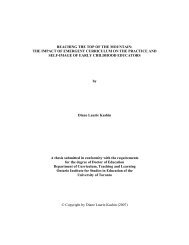The Reading Chair
You also want an ePaper? Increase the reach of your titles
YUMPU automatically turns print PDFs into web optimized ePapers that Google loves.
After reading this book to children, teachers can<br />
Books<br />
• involve children in brainstorming questions about the natural world and<br />
coming up with possible answers. Add to the list whenever a new question<br />
arises. <strong>The</strong>n the children and teacher can explore additional print and Internet<br />
resources to find out the facts. Are any of the children’s answers correct<br />
or close to correct?<br />
• offer children interesting items to explore and wonder about, such as dryer<br />
lint (Where does it come from?), a bird’s nest (How do birds build their nests?<br />
What makes them strong?), or orange peels (How long will it take them to dry?<br />
How much will the peels weigh today, tomorrow, next week?).<br />
More science books<br />
About Insects: A Guide for Children, by Cathryn Sill; illus. by John Sill.<br />
An Egg Is Quiet, by Dianna Aston; illus. by Sylvia Long.<br />
Dinosaur Bones, by Bob Barner.<br />
In the Small, Small Pond, by Denise Fleming.<br />
In the Tall, Tall Grass, by Denise Fleming.<br />
Leaf Man, by Lois Ehlert.<br />
<strong>The</strong> Very Hungry Caterpillar, by Eric Carle.<br />
Blocks and building<br />
Books related to construction and everyday life inspire children to re-create<br />
their physical surroundings. Blocks foster creativity, imagination, and empowerment.<br />
<strong>The</strong>y allow children to envision a castle or a truck on their<br />
own, rather than relying on toy manufacturers to determine the details for<br />
them. Maps, road signs, and construction helmets are wonderful accessories<br />
in the block area, and books featuring these items are essential. Busy<br />
builders can also learn to use carpentry tools in an indoor or outdoor<br />
woodworking area.<br />
Tools<br />
Written and illustrated by Taro Miura.<br />
This stunning book, with computer-made illustrations that look like paper<br />
collage, features more than 60 tools, from the common saw to the less familiar<br />
soldering iron. Children will enjoy the guessing-game format, in which they<br />
examine a set of tools before finding out who uses them. <strong>The</strong> carpenter uses a<br />
clamp, hammer, and chisel. <strong>The</strong> (female) doctor uses a stethoscope, syringe,<br />
and tweezers.<br />
Miura’s attention to detail creates a rewarding book. Without overwhelming<br />
the reader, he always offers something extra, like side-by-side comparisons of<br />
an open-end wrench and an adjustable wrench, a knife and a cleaver, a shovel<br />
and trowel. This book contains rich vocabulary and bold illustrations, all with<br />
seamless simplicity.<br />
Beyond the Journal • Young Children on the Web • May 2007


















